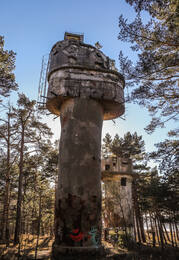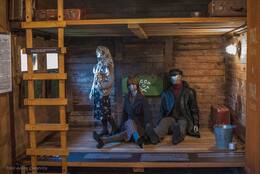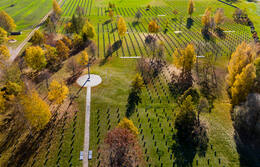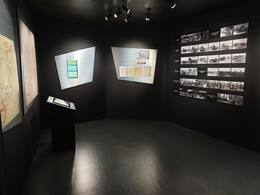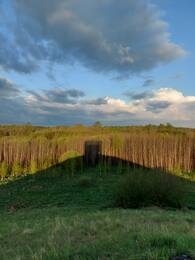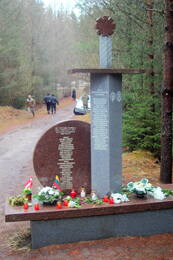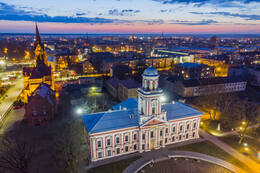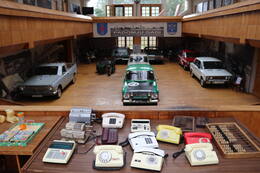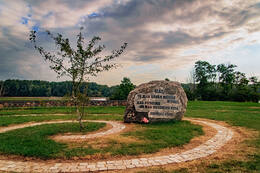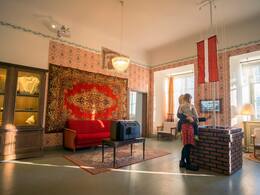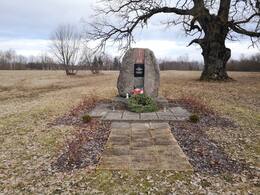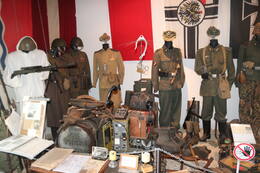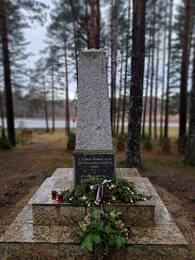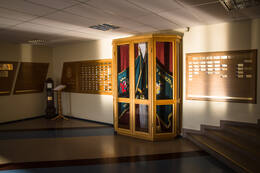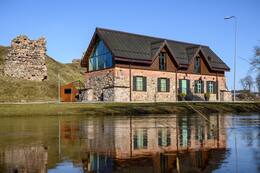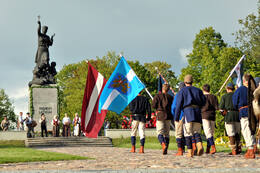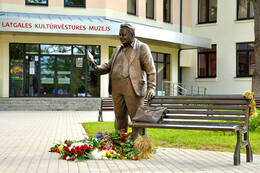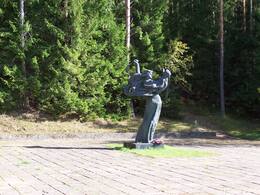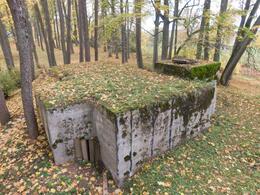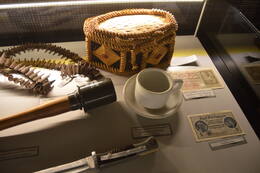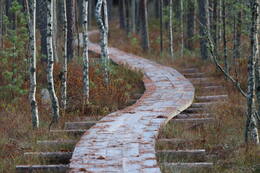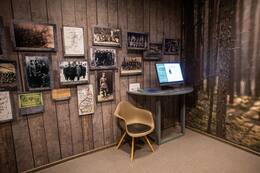Antrasis pasaulinis karas ir jo padariniai – sovietinė okupacija Pietų Latvijoje ir Latgaloje
Karosta, Liepojos karinis uostas (ekskursija)
Karosta yra didžiausia istorinė karinė teritorija Baltijos šalyse ir užima beveik trečdalį visos Liepojos teritorijos. Karosta – unikalus karinių ir įtvirtinimų pastatų kompleksas Baltijos jūros pakrantėje, turintis ypatingą reikšmę Latvijos ir pasaulio istorijoje bei architektūroje. Karostoje yra tokie karinio paveldo objektai kaip Šiaurinis molas ir fortai, Redanas, Karostos kalėjimas, Karostos vandens bokštas, Šv. Nikolajaus stačiatikių Jūros katedra, Oskaro Kalpako tiltas ir kiti.
Trėmimams naudotas galvijų vagonas – muziejus Skrundos geležinkelio stotyje
1941 m. birželio ir 1949 m. kovo mėn. trėmimams atminti Skrundos geležinkelio stotyje pastatytas atminimo akmuo ir keturašis vagonas, kuris taip pat tarnauja kaip trėmimams skirtas muziejus. Tai pirmasis vagono tipo muziejus Latvijoje, kuriame nuolat eksponuojamos iš Skrundos stoties ištremtų žmonių nuotraukos, laiškai, atsiminimai, dokumentai ir įvairūs daiktai. Skrundos stotis buvo tremtinių surinkimo vieta ir viena iš trijų regiono stočių, į kurią buvo atvežti žmonės iš Skrundos ir Kuldygos apylinkių. 1941 m. iš čia į Krasnojarsko kraštą Sibire buvo ištremta pirmojo atkurtos Latvijos Respublikos prezidento Gunčio Ulmanio šeima.
Deportacijų pagalba sovietai susidorojo su nacionalinių partizanų šalininkais ir tuo pačiu metu baugino likusius kaimo gyventojus, versdami juos stoti į kolūkius.
Saldaus vokiečių kareivių kapinės
Saldaus vokiečių kareivių kapinės yra prie Saldaus–Ežerės plento. Kapinėse, užimančiose 8 hektarų plotą, yra apie 25 000 vokiečių kareivių, taip pat kai kurių Latvijos legionierių palaikai. Perlaidojimai vyksta nuo 1997 m.
Nuo gegužės 1 d. iki spalio 1 d. memorialiniame kambaryje galima apžiūrėti parodą apie Kuršo mūšius. Šiuo laikotarpiu memorialinis kambarys dirba darbo dienomis nuo 9:00 iki 17:00 val., o šeštadieniais ir sekmadieniais kapinėse dirba ir gidas. Taip pat galima susipažinti su Saldaus vokiečių kareivių kapinėse palaidotų ir visoje Latvijoje žuvusių kareivių sąrašais.
Ezerės kraštotyros saugykla „Muitas Nams“
Ezerės muitinė yra Ezerėje, netoli Saldaus-Mažeikių plento, Latvijos ir Lietuvos pasienyje. 1945 m. gegužės 8 d. šiame pastate buvo pasirašytas vadinamojoje „Kuršo kišenėje“ apsuptų Vokietijos armijos dalinių „Kurzeme“ (Kurlandas) kapituliacijos aktas. Manoma, kad Antrasis pasaulinis karas iš tikrųjų baigėsi Ezerėje. Muitinėje yra ekspozicija, kurioje aprašomi Antrojo pasaulinio karo pabaigos įvykiai, ir eksponatai, kuriuose išsamiai aprašoma Ezerės parapijos istorija nuo seniausių laikų iki šių dienų. 1945 m. gegužės 7 d. rytą Leningrado fronto vadas maršalas L. Govorovas išsiuntė armijų grupės „Kurzeme“ vadovybei ultimatumą sudėti ginklus. Kapituliacijos aktą susijusios šalys pasirašė gegužės 8 d., jame išsamiai aprašyta perdavimo tvarka, ginklų surinkimo punktai, pateiktini dokumentai ir informacija bei kitos praktinės priemonės.
Sovietų oro pajėgų taikinių šaudymo vieta Zvarde
Zvārdės poligonas yra Zvārdės savivaldybėje, Saldaus rajone. Tai buvęs SSRS karinės aviacijos poligonas, užimantis daugiau nei 24 000 hektarų.
Buvusio aerodromo teritorijoje yra keletas objektų: Karininkų kurganas, Zvārdės ir Ķērklinių bažnyčių griuvėsiai, Rītelių kapinės, buvusi kariuomenės bazė „Lapsas“ ir kiti. Iki Antrojo pasaulinio karo apžvalgos bokšto vietoje stovėjo „Vairogų“ namas. Statant poligoną, tai, kas liko iš ūkio – sienos, obelyno liekanos ir dalis Veczvārdės dvaro griuvėsių – buvo sukrauta į pylimą, o ant jo pastatytas apžvalgos bokštas. Jis buvo naudojamas kaip apžvalgos aikštelė kariuomenės mokomiesiems manevrams koordinuoti. Ši vieta populiariai vadinama kurganu. Nuo piliakalnio atsiveria vaizdas į buvusį poligoną ir Zvardės gamtos parko bei gamtos rezervato miškingas vietoves. Gera vieta stebėti paukščius. Kurgano apylinkės nėra apželdintos.
Ylės nacionalinių partizanų bunkeris
Bunkeris yra Zebrenės seniūnijoje, Ylės girininkijoje, išsukus iš kelio P104 Bikstai–Aucė.
Ylės nacionalinių partizanų grupė, kuriai vadovavo Karlis Krauja, susikūrė 1947 m. Grupės vadu buvo išrinktas V. Ž. Briz ga (slapyvardis K. Krauja). 1948 m. spalį ši grupė susijungė su lietuvių nacionalinių partizanų grupe. Kraujos grupė veikė Jelgavos apskrityje, joje buvo 27 nacionaliniai partizanai. 1948 m. spalį Jelgavos apskrities Lielaucės valsčiuje, netoli Ylės girininkijos, 300 m į šiaurę nuo sodybos „Priedaiši“, Krau jos grupė įsirengė požeminį bunkerį. Jo bendras ilgis, įskai tant slaptus priėjimus, buvo 45 metrai. Aplink bunkerį buvo išdėliota 70 nuotoliniu būdu valdomų minų. Bunkeryje buvo įrengta krosnis, šulinys, tualetas ir sandėlis. 1949 m. kovo 17 d. bunkeryje buvę 24 partizanai stojo į savo paskutinį mūšį su 760 Valstybės saugumo ministerijos (čekis tų) karių. Po mūšio 9 partizanai buvo suimti, o 15 žuvo, iš jų – 8 latviai ir 7 lietuviai. 1992 m. krašto apsaugos kariai kartu su Dauguvos vanagais atkūrė susprogdintą bunkerį. Toje vietoje pastatytas Baltasis kryžius, paminklinis akmuo ir granito stela. Bunkerio viduje yra krosnelė, stalas ir siauri gultai, ant kurių miegojo partizanai.
Prie bunkerio yra informacijos stendai, paminkliniai akmenys su partizanų vardais ir pavardėmis.
St. The tower of the Trinity Church in Jelgava, Akadēmijas Street 1, where Egon Užkurelis hoisted a homemade Latvian flag in 1952
In the tower of the St. Trinity Church in Jelgava, which was destroyed in the Soviet-German war in July-August 1944, on October 12, 1952, Egons Užkurelis, who was only 14 years old at the time, together with his friend Jānis Ģēģeris, who was a year older, hung a homemade Latvian national flag. This date was chosen because it was a Sunday when the Jelgava championship motorcycle racing took place in Pārlielupe, where many people gathered and from there the church tower could be clearly seen. The flag was made from a bed sheet, painted with watercolors. The way it was made later allowed the Chekists to guess that the flag-raisers should be sought among the students.
E. Užkurelis and J. Ģēģeri were arrested on October 23, 1952, followed by interrogation in Jelgava and at the Ministry of State Security of the Latvian SSR in Riga at the Corner House. The Criminal Court of the Riga Regional Court accused E. Užkurelis and J. Ģēģeri of anti-Soviet propaganda and agitation and participation in a counter-revolutionary organization. On January 10, 1953, E. Užkurelis was sentenced to five years in prison, and J. Ģēģeris to 15 years. E. Užkurelis was detained in Riga Central Prison for seven months until April 12, 1953, when he was released on the basis of an amnesty.
G. Eliaso Jelgavos istorijos ir meno muziejus
G. Eliaso Jelgavos istorijos ir meno muziejus įsikūręs pastate, vadinamame Academia Petrina (Petro akademija). Jis buvo pastatytas 1775 m. kaip pirmasis universitetas Latvijoje ir yra vienas iš nedaugelio Jelgavoje Jelgavoje išlikusių ir po Antrojo pasaulinio karo restauruotų visuomeninių pastatų. 1944-ųjų vasarą Jelgava prarado beveik viską – didelę dalį gyventojų ir istorinių pastatų, kurių dauguma po Antrojo pa saulinio karo taip ir nebuvo atstatyti. Dabartinio muziejaus pirmtakas – Kuržemės provincijos muziejus, įkurtas 1818 m. Tai buvo antras pagal senumą muziejus Latvijoje ir pirmasis už Rygos ribų. Nuo 1952 m. pastate veikia Academia Petri na muziejus. Šiandien muziejuje veikia nuolatinės parodos apie iškilų Latvijos menininką Ģedertą Eliasą (1887–1975), priešistorę ir viduramžius Žiemgaloje bei Jelgavos miestą įvairiais laikotarpiais – Kuržemės ir Žiemgalos kunigaikštys tės (1561–1795 m.), Kuržemės gubernijos (1795–1918 m.) ir nepriklausomos Latvijos valstybės (1918–1940 m.) Muziejaus ekspozicija „Gyvenimas tęsiasi valdant sveti miems“ pasakoja apie gyvenimą Latvijoje vokiečių ir so vietų okupacijų metais. Virtualioje muziejaus parodoje „Karai ir kareivis Jelgavos amžiais“ galima susipažinti su įvairiais Jelgavą palietusiais karais, įskaitant ir Pirmojo bei Antrojo pasaulinių karų isto rinius įvykius.
Atminimo memorialas „Sinagogos sodas“ (Sinagogas dārzs)
Memorialas yra miesto centre, netoli Bauskės savivaldybės Turizmo informacijos centro ir Rotušės aikštės. Jis sukurtas Bauskės žydų palikuonių Izraelyje, JAV ir Di džiojoje Britanijoje iniciatyva ir aukomis, taip pat Bauskės savivaldybės tarybos ir Latvijos žydų bendruomenių bei bendrijų paramos dėka. Memorialą suprojektavo skulptorius Girtis Burvis. Jis yra buvusios Bauskės Didžiosios sinagogos dydžio, o akmens statulos simbolizuoja žydus, išeinančius iš sinagogos po pamaldų. Memorialo centre stovi simbolinė bima – pa aukštinta platforma arba stalas, naudojamas sinagogoje per žydų religines apeigas. Ant jos parašyta: „Pagarba Bauskės žydams, kurie čia gyveno šimtmečius ir kūrė šį miestą, o 1941 m. buvo nužudyti nacių ir jų vietinių parankinių. Pagerbiant žydų tautos atminimą – Bauskės žydų palikuonys ir Bauskės gyventojai.“ 1935 m. Bauskėje gyveno beveik 800 žydų. 1941 m. liepą, prasidėjus nacių okupacijai, daug žydų buvo suimti ir iš vežti, o apie 700 žydų sušaudyti. Bauskės Didžioji sinagoga buvo sugriauta per Antrąjį pasaulinį karą.
Aizkrauklės istorijos ir meno muziejaus ekspozicija „Sovietmetis“
Minint Latvijos šimtmetį, 2018 m. lapkritį Aizkrauklės seniū nijos kultūros namuose pradėjo veikti Aizkrauklės istorijos ir meno muziejaus ekspozicija „Sovietmetis“ – didžiausia ekspozicija Baltijos šalyse, skirta XX amžiaus (1950–1980 m.) kultūriniam ir istoriniam paveldui. Ekspozicija išdėsty ta per tris aukštus ir užima 1060 m2 plotą. Joje pristatomi įvairūs gyvenimo sovietmečiu aspektai: buitis, darbas ir laisvalaikis, švietimas ir kultūra. Pirmajame aukšte ekspo nuojami sovietmečio automobiliai. Atskirai įrengta biblio teka – Raudonasis kampelis. Įvairialypė ekspozicija kvie čia susipažinti su sovietmečio kasdienybe ir butų interjeru – baldais, buities reikmenimis, indais, tekstilės gaminiais ir elektros prietaisais. Kitos ekspozicijos erdvės skirtos emigracijai, sovietinių laikų represijoms, kasdieniam gyvenimui, medicinai, valstybės institucijoms, turizmui ir sportui, vaikystei bei švietimui. Gali ma apžiūrėti SSRS karinę atributiką ir uniformas.
Sibiro motinoms skirta atminimo vieta „Likimo sodas“ (Likteņdārzā)
Atminimo vieta „Likimo sodas“, skirta Sibiro motinoms, įrengta Dauguvos saloje, netoli Kuoknesės pilies griuvėsių. Tai kraštovaizdžio architektūros ansamblis, skirtas XX a. Latvijos žmonių atminimui – tų, kurie žuvo karuose, buvo represuoti, priverstinai ištremti ar kitaip nukentėjo dėl savo politinių pažiūrų. Kaip ir Laisvės paminklas Rygoje, „Likimo sodas“ buvo sukurtas žmonių aukų dėka. Bendradarbiaujant su Latvijos politiškai represuotų asme nų sąjunga, virtualiajame Tylos namų centre buvo įreng tas ansamblis, skirtas į Sibirą ištremtų moterų – Sibiro vaikų motinų – atminimui. Jų pasiaukojimą ir savęs atsižadėjimą simbolizuoja du rieduliai su iškaltais žodžiais: „Motin, tu man du kartus padovanojai gyvybę. Kai gimiau ir kai nemiriau iš bado. Sibiro vaikas.“ Atminimo vietoje „Likimo sodas“ taip pat išlikusios Pirmojo pasaulinio karo tranšėjos. Netoliese įrengta latviams šau liams skirta atminimo vieta, iškilmingai atidengta minint šaulių pulkų įkūrimo 100-ųjų metines. Vietovės kompozicija suskirstyta į dvi dalis: iš Latvijos laukų atgabentų riedulių grupė simbolizuoja tuos, kurie liko namuose, o riedulių linija, esanti Pirmojo pasaulinio karo tranšėjose, – latvių šaulius. Akmenis parinko ir menišką kompoziciją sukūrė skulptorius Ojaras Feldbergas.
Paroda „Kovos už laisvę XX amžiuje“ Jėkabpilio istorijos muziejuje
Įsikūręs Krustpilio pilyje
Paroda „Kovos už laisvę XX amžiuje“
Sovietinės represijos. Sunkūs prisiminimai. Sėdėdami čia, klubo kėdėje, turite galimybę pasiklausyti Jėkabpilio gyventojo Ilmāro Knagio knygos „Buvo tokie laikai“ ištraukų. Ant vienos iš kambario sienų bejausmiškai, tarsi titrai po filmo, slenka į Sibirą ištremtų piliečių sąrašas. Ten pat, sename televizoriuje, galite žiūrėti mėgėjišką vaizdo įrašą apie Lenino paminklo pašalinimą Jėkabpilyje. Lankytojus domina ne tik turinys, bet ir techninės galimybės – kaip šis filmas buvo sukurtas sename televizoriuje.
Jekabpilio istorijos muziejuje galima pasiklausyti muziejaus specialistų parengtų paskaitų arba užsiregistruoti į ekskursiją: Jekabpilis ir jo apylinkės Pirmojo pasaulinio karo metu, Jekabpilis 1990 m., Barikadų metas, 1949 m. trėmimai – 70, Jėkabpiliečiai – Lačplėšio karo ordino kavalieriai ir kt.
Vidutinė paskaitų trukmė – 40 minučių. Informacijos ir registracijos į paskaitas teirautis telefonu 65221042, 27008136.
Jekabpilio istorijos muziejus įsikūręs Krustpilio pilyje. 1940 m., Latviją prijungus prie SSRS, Krustpilio pilyje buvo dislokuota 126-oji šaulių divizija. Antrojo pasaulinio karo metu pilyje buvo įsikūrusi vokiečių ligoninė, o po 1944 m. rugpjūčio mėn. – Raudonosios armijos karo ligoninė. Po karo Krustpilio pilyje ir gretimuose dvaro pastatuose buvo įsikūrę 16-ojo tolimojo nuotolio žvalgybos aviacijos pulko ir 15-osios sovietinės armijos oro armijos centriniai sandėliai.
Nacionalinių partizanų paminklas Jersikoje
Paminklinis akmuo randasi netoli Jersikos geležinkelio stoties. Ant jo iškaltas užrašas: „LTS(p)A – Latvijos Tėvynės sargybinių (partizanų) junginio kovotojams“. Šis partizanų junginys, kovojęs su komunistiniu okupaciniu režimu, 1945 1955 m. vienijo partizanus iš šešių Latvijos apygardų. Paminklinis akmuo yra pirmoji stotelė žygyje „Jersika–Vana gai. Nacionalinių partizanų legendų pėdsakais.“ Maršrutas prasideda prie Jersikos stoties. Keliaujant galima susipažinti su nacionalinių partizanų judėjimo istorija, žymiausiais par tizanais ir jų veikla. Toliau kelias veda į miškų glūdumoje paslėpto nacionalinių partizanų bunkerio vietą; liudininkų pasakojimuose nurodytą Tėvynės sargybinių (partizanų) junginio įkūrimo vietą; miške esančią atminimo vietą Avuo tnica (latgališkai – Olūtneica), kur įrengta laužavietė. Žygio tikslas – Vanagų bažnyčia, kurioje pamaldas laikė kunigas Antonas Juchnevičius. Apie jį sukurtas filmas „Slapyvardis Vienišius“ (rež. Normundas Pucis).
Filme pasakojama apie kunigą, kuris pokariu aktyviai dalyvavo nacionalinių parti zanų pasipriešinime Latgaloje. Maršrutas driekiasi buvusių sodybų vietomis, kur dar galima aptikti jų pėdsakų – didin gų ąžuolų, pastatų griuvėsių. Žygiuojama miškais, pelkėmis, raistais, pievomis ir kaimo keliukais. Bendras trasos ilgis – apie 22 km, o ją įveikti gali ma per maždaug 6 valandas.
Jersika National Partisan Hiking Route
A hard-to-find natural object. Hike length: approximately 22 km, can be completed in approximately 6 hours.
Hike length: approximately 22 km, can be completed in 6 hours.
Difficulty level: medium fitness hike.
Starting point: Jersika Elementary School (can be reached by train, bus).
End point: Vanagu Church (public transport does not run on weekends).
Note: The route includes a swimming break (during the summer season), fishing opportunities, a picnic area, and one public toilet. The route is also suitable for school-age children who already have experience in hiking of this length.
Go on a hike from Jersika to Vanagi, allowing yourself to be challenged in endurance, as the hike leads through forests, swamps, moors, meadows and country paths, and in the historical knowledge of the most prominent figures of the national partisan movement, their activities, see the most significant places about which local legends and written memories of fellow citizens are told. The path begins at the Jersika elementary school and leads to a memorial stone under an old oak tree, further along the way including the Jersika railway station. The inscription on the stone reads “LTS(p)A – For the fighters of the Latvian Fatherland Partisan Association. LTS(p)A united the national partisans of six Latvian districts in the fight against the communist occupation regime in 1945-1955”.
The walk continues along the railway tracks and winds along Lake Jersika, where the forest presents natural treasures: spring-flowering primroses and common sedge. The smell of primroses indicates that you are approaching the bog, but in spring it is especially surprising to see them blooming. A lazy walk is not possible, several ditches must be overcome, crossing the bog provides a tempering - water remains in the moss at every step, cranberry berries shine in the bushes. The bog is replaced by a forest and evidence of the former settlement of these places in homesteads - stately oaks, ruins of buildings, the site of a national partisan bunker surrounded by young growth. The path continues to the place mentioned in the testimonies as the place of founding of the Fatherland Guards (partisans) association. The forest massif also hides the memorial site “Avotnīca” (“Olūtneica”), where a campfire has been set up. The diversity of the forest is surprising, as is the width of the ditches. The destination of the hike is Vanagi Church, where priest A. Juhņevičs served, and about whom the film “Segvārds Vientulis” (directed by N. Pucis) tells the story.
WW2 – Antrojo pasaulinio karo ekspozicija Agluonoje
Antrojo pasaulinio karo ekspozicija Agluonoje – dar vadi nama Karo muziejumi – įkurta 2008 m. ir yra viena didžiau sių bei įdomiausių tokio pobūdžio ekspozicijų Latvijoje. Kolekcija nuolat papildoma naujai įsigytais eksponatais, karo dalyvių ir karo meto kartos žmonių pasakojimais. Muziejaus fondo pagrindą sudaro per Antrąjį pasaulinį karą naudoti ginklai, ekipuotė, amunicija ir uniformos.
Tai pat galima pamatyti įvairius buities reikmenis, lėktuvų nuolaužas ir kitus eksponatus. Vienas vertingiausių ir išskir tiniausių eksponatų yra karo lauko pašto laiškai tarp ober leitenanto Augusto ir jo mylimosios Martos. Penkerius karo metus trukęs dviejų mylinčių žmonių susirašinėjimas baigėsi laimingai. Ekspozicijos fone rodomos karo meto kronikos. Ekspozicija nėra politizuota – joje vienodai pristatomos abi kariaujančios pusės, todėl lankytojai turi galimybę neskirs tydami į gerą ir blogą, lengvai suprasti ekspoziciją.
Monument to the Latvian Freedom Struggles at the site of the battles of the 3rd Jelgava Infantry Regiment
Monument to the 3rd Jelgava Infantry Regiment's January 16, 1920, freedom struggle in Latgale. With the inscription: “The place of the 3rd Jelgava Infantry Regiment's battles, the victory march through Latgale. 1920.16.I. We brought the sun, freedom and independence to Latvia”
The monument was unveiled in 1936. On August 16, General Žanis Bachs (1885–1941) consecrated it by Pastor Ādams Vizulis (1891–1970). The author of the monument's design was Engineer Zilēvičs.
The Latvian War of Independence (1918–1920) operation to liberate Latgale began on January 3, 1920. By mid-January, the Latvian and Polish armies had liberated Daugavpils and most of southern Latgale up to the Dagda–Indra line from the Bolshevik forces that had seized power in Russia. On January 9, the Latvian army began its offensive in Northern Latgale, rapidly advancing towards the Kārsava and Pitalova stations.
In the middle between the two directions of attack remained the Bolshevik-controlled area around Varakļāni, Viļāni and Rēzekne. On January 20, Latvian army units began the operation to liberate Rēzekne. Rēzekne was liberated on January 21. The Latvian army, across the entire expanse of the Eastern Front, reached the border of Latvian-inhabited lands by the end of January. Already on February 1, Soviet Russia signed an armistice agreement with Latvia.
With the victory in the Battles of Latgale, Latvia's eastern border was secured and the opportunity to annex Latgale to Latvia was gained. The Latvian army achieved the final unification and independence of Latvia in 1920.
The monument, dated 1920.16.I., is dedicated to the moment when the 3rd Jelgava Infantry Regiment took up its starting positions before the operation to liberate Rēzekne.
Valstybės sienos apsaugos muziejus
Muziejus įsikūręs Latvijos valstybės sienos apsaugos kolegi jos patalpose Rėzeknėje.
Muziejuje veikia Sienos apsaugos istorijos tyrimų skyriaus ekspozicija, supažindinanti su Latvijos sienos apsaugos is torijos chronologija nuo 1919 m. iki šių laikų. Surinkti daiktai ir nuotraukos pasakoja apie Latvijos pasieniečių tarnybą ir kasdienį gyvenimą nuo 1919 m. iki 1940 m. Taip pat at skleidžiamas tragiškas pasieniečių likimas po 1940 m. šalies okupacijos. Tuo metu pasieniečiai kartu su savo artimaisiais buvo vieni pirmųjų represuotų asmenų. Muziejuje eksponuojami daiktai, susiję su atkurtos Sienos apsaugos tarnybos veikla po Latvijos nepriklausomybės atkūrimo: uniformos, ekipuotė, apdovanojimai ir skiriamieji ženklai, kurie laikui bėgant buvo nuolat tobulinami ir keitėsi. Neatsiejama ekskursijos dalis – apsilankymas Kinologijos centre, kur galima stebėti dresuojamų tarnybinių šunų pasirodymus.
Apsilankymui būtina išankstinė registracija.
Laisvosios valstybės brangenybių namai
Nepriklausomos valstybės palikimą saugantys namai yra šalia Rėzeknės pilies griuvėsių.
Išskirtinėje ekspozicijoje pristatoma keli šimtai istorinių eks ponatų iš Latvijos ir užsienio privačių kolekcijų, apimančių 1918–1940 m. laikotarpį, bei skirtingus Latgalos ir Rėzeknės istorijos puslapius. Supažindinama su Pirmosios nepriklau somos Latvijos valstybės karinių ir civilinių apdovanojimų istorija, įvairių valstybinių ir visuomeninių organizacijų vei kla, vykusia nuo Latvijos nepriklausomybės karo iki Antrojo pasaulinio karo.
Tai didžiausia Latvijoje kolekcija, pristatanti nepriklausomos valstybės karinius ir civilinius apdovanojimus bei skiriamuo sius ženklus. Antrajame aukšte įrengta keičiamų parodų salė, kurioje bent kartą per metus surengiama nauja paroda.
Lankyto jai jau turėjo galimybę pamatyti išskirtinę porceliano dirbi nių kolekciją, prabangius laikrodžius iš Prancūzijos ir įvairius Latgalos peizažus vaizduojančius paveikslus
Paminklas „Vieningi dėl Latvijos“ (Vienoti Latvijai) arba Latgalos Mara
Rėzeknėje stovi paminklas „Vieningi dėl Latvijos“, žmonių vadinamas „Latgalos Mara“. Pagrindinė figūra – moteris su kryžiumi rankoje – simbolizuoja 1920 m. iš bolševikų valdžios išvaduotą Latgalą ir jos krikščionišką dvasią. Paminklo idėja gimė XX a. 3 deš. pabaigoje, ją inicijavo Lat galos visuomenės veikėjai. 1930 m. birželio 8 d. buvo pašven tintas pirmasis paminklo pamatų akmuo. 1934 m. birželį buvo paskelbtas konkursas, kurį laimėjo Karlio Jansono projektas. 1939 m. rugsėjo 8 d. paminklas iškilmingai atidengtas. Pašven tinimo apeigoms vadovavo vyskupas Jazepas Rancanas. Sovietų okupacijos laikotarpiu, 1940 m. lapkritį paminklas buvo nugriautas. Bronzinės skulptūros sunaikinti nespėjo, todėl vokiečių okupacijos metais, 1943 m. rugpjūčio 22 d. paminklas buvo atstatytas. Grįžus sovietų okupacijai, iš pradžių buvo nupjautas kryžius, o 1950 m. paminklas visiškai sunaikintas. Jo vietoje buvo pastatytas Lenino paminklas, kuris buvo nu griautas iškart po Latvijos nepriklausomybės atgavimo 1991 m. Atgimimo laikotarpiu, 1989 metais, kilo idėja atkurti istorinį paminklą „Vieningi dėl Latvijos“. Paminklą, remdamasis savo tėvo medžiaga ir nuotraukomis, atkūrė Karlio Jansono sūnus skulptorius Andrejus Jansonas kartu su Inta Folkmane. Atnau jintas paminklas buvo atidengtas 1992 m. rugpjūčio 13 d. per Pirmąjį pasaulinį latgalių susitikimą.
Latgalos kultūros istorijos muziejus
Latgalos kultūros istorijos muziejuje Rėzeknėje veikia trys nuolatinės ekspozicijos. Viena jų – „Rėzeknė laikmečių san dūroje“ – pasakoja apie daugiau kaip septynis šimtmečius besitęsiančią miesto istoriją. Didelė ekspozicijos dalis skirta XX a. įvykiams, karams ir besikeitusiems laikotarpiams: Pir masis pasaulinis karas, Nepriklausomybės karas, Antrasis pasaulinis karas, 1944 m. sovietų bombonešių antskrydis, taip pat karo belaisvių stovykla „Stalag 347“. Ekspozicijoje yra fotografijų stendas, skirtas Rėzeknės kareivių likimams karo metais. Latvijos nepriklausomybės laikais Rėzeknėje buvo dislokuo tas Latvijos kariuomenės 9-asis Rėzeknės pėstininkų pulkas, kuris tapo neatsiejama miesto visuomeninio gyvenimo ir sporto renginių dalimi – ypač per lapkričio 11 d. (Laisvės gynėjų dienos) ir lapkričio 18 d. (Latvijos nepriklausomybės dienos) minėjimus.
Ančupanų memorialas Antrojo pasaulinio karo aukoms atminti
Memorialas yra Ančupanuose, Rėzeknės apskrityje. Jis buvo sukurtas, siekiant įamžinti Audrinių tragediją – 1942 m. naci stinės Vokietijos okupacijos metu įvykdytą civilių gyventojų naikinimo operaciją Audrinių kaime, Makašanų seniūnijoje, Rėzeknės apskrityje. Nuo 1941 m. rudens Audriniuose slapstėsi keli pabėgę Rau donosios armijos karo belaisviai.
1941 m. gruodžio 18 d. buvo nustatyta jų buvimo vieta, ir per susišaudymą žuvo 4 pagalbi nės saugumo policijos pareigūnai. Gruodžio 24 d. 203 Audri nių gyventojai buvo suimti ir įkalinti Rėzeknės kalėjime. 1942 m. sausio 3 d. dauguma suimtųjų buvo sušaudyti netoli An čupanų kalvos, maždaug už 5 km nuo Rėzeknės. Sausio 4 d. Rėzeknės turgaus aikštėje viešai buvo sušaudyta 30 Audrinių kaime suimtų vyrų, o pats kaimas sudegintas. Memorialas atidengtas 1974 m. liepos 27 d. Jo autorius – kraš tovaizdžio architektas Alfonsas Kiškis (1910–1994). Dešinėje kelio pusėje augančios nuolat žaliuojančios eglės simboli zuoja žmones, išrikiuotus į eilę sušaudymui, o kitoje kelio pu sėje esanti akmeninė siena – šaudytojus. Žemesnėje dalyje – Kančios slėnyje – pro masines sušaudytų žmonių kapavietes veda lauko rieduliais grįstas takas, kuris baigiasi prie betoni nės sienos su užrašu: „Jie mirė, kad gyventum tu“. Toliau kyla laiptai į Gyvybės aikštę, kur stovi skulptūra „Motina obelis“, kurią sukūrė skulptorė Rasa Kalninia-Grinberga (1936 m.).
Antrojo pasaulinio karo bunkeriai Malnavoje ir Hitlerio apsilankymas vo kiečių armijos grupės „Šiaurė“ štabe
Hitlerio apsilankymas vokiečių armijos grupės „Šiaurė“ štabe Malnavoje ir netoliese esantis priešlėktuvinės gynybos bun keris dažnai minimi kaip susiję objektai. Tačiau juos sieja tik bendra vieta – Malnavos dvaras; jokio tiesioginio ryšio tarp šių įvykių nėra. 1941 m. liepos 12–28 d. Malnavos dvare buvo įsikūręs vokiečių armijos grupės „Šiaurė“ štabas vadovavęs puolimui Leningra do kryptimi. Vieta buvo pasirinkta dėl praktinių priežasčių – buvusiame dvare veikusi Malnavos žemės ūkio mokykla turėjo modernią infrastruktūrą: elektros apšvietimą, centralizuotą vandentiekį, dušus ir kanalizaciją. Štabas buvo įrengtas viena me iš dvaro šoninių korpusų, o likusioje pastato dalyje mokykla veikė toliau. Hitleris štabą aplankė 1941 m. liepos 21 d. Jis kartu su lydinčiais asmenimis atskrido dviem „Junkers“ lėktuvais, lydimais devy nių „Messerschmitt“ naikintuvų. Apsilankymas truko vos kelias valandas, bet buvo įamžintas vokiečių fronto kino kronikose ir išliko Malnavos mokinių prisiminimuose. Maždaug už 70 metrų nuo dvaro stovi priešlėktuvinės gynybos bunkeris, įrengtas 1944 m. pradžioje, kai karo eigoje sovietų aviacija ėmė dominuoti oro erdvėje, o vokiečių karinės pajė gos pradėjo trauktis. Grupės „Šiaurė“ štabas Malnavoje buvo nuo vasario iki liepos vidurio.
Privati ekspozicija „Abrenės kambariai“ (Abrenes istabas)
Privati ekspozicija „Abrenės kambariai“ įsikūrusi Viliakos mieste, istoriniame pastate. Iš pradžių šis pastatas stovėjo senosios Marienhauzeno turgaus aikštėje. Vėliau čia vei kė butai, biurai, įvairios parduotuvės, o Antrojo pasaulinio karo metais – latvių savigynos štabas, gestapas ir čekistų būstinė. Ekspozicijose pristatomi įvairūs Viliakos ir jos apylinkių isto rijos laikotarpiai bei įvykiai nuo 1920 iki 1960 metų – kai miestelis priklausė Jaunlatgalės, vėliau Abrenės apskri čiai. Tarp eksponatų – Stompakų pelkės partizanų štabo daiktai, pasakojantys apie nacionalinį pasipriešinimą Lat galoje, taip pat dokumentai ir fotografijos iš Nepriklauso mybės kovų laikotarpio. Naujausioje ekspozicijoje lankytojai gali susipažinti su ka daise garsia motokroso trasa „Baltasis briedis“.
Viliakos muziejus
Viliakos muziejus įsikūręs dviejuose pastatuose – 1913 m. statytuose miestelio kultūros istorijai svarbiuose katalikų parapijos namuose ir buvusiame kapucinų vienuolyne, kurio rūsiai glaudžiai susiję su nacionalinių partizanų judėji mu Stompakuose ir sovietų čekistų veikla. Žmonės prisime na, kad šiuose rūsiuose buvo laikomi ir kankinami žmonės. Senajame muziejaus pastate įrengtos kelios ekspozicijos. Viena jų pristato 1920 m. laisvės kovas Šiaurės Latgaloje, Antrojo pasaulinio karo įvykius – žydų holokaustą Viliakoje ir informaciją apie sušaudytas šeimas. Daugiau apie kie kvieną šeimą galima sužinoti pagal gyvenamosios vietos adresą.
Ekspoziciją papildo informacija apie nacionali nių partizanų judėjimą Stompakuose – įvairūs eksponatai: nuotraukos, daiktai. Muziejaus lankytojai gali susipažinti su karinio paveldo vietomis Viliakoje ir jos aplinkinėse vie tovėse, pavyzdžiui, kovotojų už Laisvę paminklu Jaškove, kuris sovietmečiu buvo nugriautas ir atstatytas 1990 m., stela, skirta Lačplėsio karo ordinu apdovanotiesiems. Mu ziejaus ekspozicijoje girdisi Antrojo pasaulinio karo lėktuvo garsas, kaip priminimas apie netoli Viliakos buvo vokiečių aerodromas „Luftwaffe“. Muziejuje galima susipažinti su prisiminimais apie Antrojo pasaulinio karo įvykius Viliakoje ir gauti informacijos apie vokiečių karo belaisvių stovyklą Račuose.
Nacionalinių partizanų būstinė gamtos draustinyje „Stompakų pelkės“ (Stompaku purvi)
Antrojo pasaulinio karo metais Stompakų pelkėje buvo viena didžiausių nacionalinių partizanų būstinių Baltijos šalyse. Šiandien ši teritorija priklauso Stompakų gamtos draustiniui.
Pelkių salose esančią gyvenvietę galima pa siekti pažymėtu pėsčiųjų taku. 1945 m. pradžioje Stompakų pelkėje buvusioje nacionali nių partizanų būstinėje gyveno 350–360 žmonių, iš jų – 40 50 moterų. Joje buvo 24 gyvenamieji bunkeriai – pusiau į žemę įkasti statiniai, kuriuose galėjo gyventi 3–8 žmonės. Būstinėje taip pat veikė kepykla, požeminė bažnyčia ir trys antžeminės pašiūrės arkliams. Partizanai rengė išpuo lius prieš okupacinio režimo pareigūnus. 1945 m. kovo 2–3 d. čia vyko Stompakų mūšis – didžiau sias nacionalinių partizanų susirėmimas Latvijoje. Būstinė je buvusius 350–360 partizanų puolė NKVD 143-asis šaulių pulkas ir vietinio stribų (rus. „isterbiteli“) bataliono kovoto jai – iš viso 483 vyrai. Mūšis truko visą kovo 2 dieną. Kovo 3-iosios naktį partizanams pavyko ištrūkti iš būstinės ir pasi traukti į ankstesnės bazės vietą. Mūšyje žuvo 28 partizanai, o NKVD neteko 32 karių. Šiuo metu Stompakų būstinės vietoje yra atkurti trys bun keriai – bažnyčia, štabas ir gyvenamasis bunkeris, taip pat 21 bunkerio vieta. Įrengti informaciniai stendai apie būsti nę ir mūšį. Galima užsisakyti ekskursijas su gidu.
Ekspozicija „Šiaurės Latgala kovose už laisvę“ (Ziemeļlatgale brīvības cīņās)
Muziejus įsikūręs Balvų dvaro komplekse, buvusiame dva ro klėties pastate. Ekspozicija supažindina su Latvijos Nepriklausomybės kovų istorija iš Šiaurės Latgalos perspektyvos, pasakoja Latgalos partizanų pulko kūrimosi ir veiklos istoriją. Čia eks ponuojamos anksčiau niekur nepublikuotos nuotraukos ir dokumentų kopijos, įskaitant 1919 m. liepos 5 d. įsakymą dėl pulko suformavimo. Ypatingą ekspozicijos dalį sudaro 1919 m. liepos–spalio mėn. rusų kalba rašyti vidiniai pulko įsakymai. Jie atskleidžia šio vietinio karinio dalinio forma vimosi ypatumus – jame kartu kovojo latviai, latgaliai, ru sai ir žydai. Tik pulkui tapus visaverte Latvijos kariuomenės dalimi ir jį papildžius mobilizuotiems kariams iš kitų Latvijos regionų, vidiniai dokumentai pradėti rengti latvių kalba. Ekspozicijoje pasakojama apie Šiaurės Latgalos išvadavi mo operaciją. 1920 m. sausio 9–15 d. Latvijos kariuome nės Latgalos divizijos vykdytų mūšių metu buvo išlaisvintos Viliakos, Jaunlatgalės ir Karsavos apylinkės. Galima apžiū rėti su šia operacija susijusius eksponatus, įskaitant ir Lat galos partizanų pulko veiklą Karsavos išvadavimo metu.




